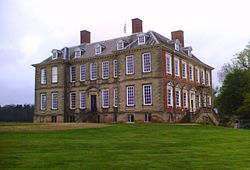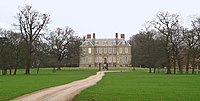Stanford Hall, Leicestershire
| Stanford Hall | |
| Leicestershire | |
|---|---|
 Stanford Hall | |
| Location | |
| Grid reference: | SP586793 |
| Location: | 52°24’31"N, 1°8’19"W |
| History | |
| Country house | |
| Information | |
Stanford Hall is a stately home in Leicestershire, near the village of Stanford on Avon (which is across the county boundary in Northamptonshire) and the Leicestershire town of Lutterworth.
History
Ancestral home of the Cave family, the hall was built in the 1690s for Sir Roger Cave on the site of an earlier manor house. It is considered a fine example of William and Mary period architecture of the late 17th century. The architect was William Smith of Warwick.
In 1792 Sarah Otway, daughter of Sir Thomas Cave Bt (who in 1790 had married Henry Otway, High Sheriff of Leicestershire in 1804), inherited the estate on the death of her nephew Sir Thomas Cave, 7th Baronet. She was created Baroness Braye in 1839. Her descendants remain in residence.
The River Avon flows through the grounds, with a weir downstream, so a small lake is formed.
The aviation pioneer Percy Pilcher built some of his early gliders here in the 1890s; he also built a powered flying machine here that many historians believe was capable of flight, but he was killed nearby in an accident in 1899 before he could try it. An exact replica of Pilcher's "The Hawk" glider is exhibited at the hall.
During Second World War the nuns and girls from the Sacred Heart Convent and School in Roehampton, Surrey, were evacuated to the Hall. Their premises were so badly damaged that when war ended they had to relocate to Woldingham School near London. From 1947 until 1949 it was the country branch of St. Mary's Town and Country School. By that time the roof was uncared for and in serious need of repair, but fortunately the Historic Buildings Council recommended a large grant for restoration and the hall was opened to the public in 1958.
Attractions
The hall is in grounds that are designated a Site of Special Scientific Interest due to the diversity of lichen species found in the park.[1]
Today the hall is a tourist attraction open to the public. Amongst the attractions are a motorcycle museum, and guided tours of the hall and its grounds. This structure also houses a significant collection of antique furnishings; for example, the hall has one room with original 17th century furnishings including a refectory table and set of Charles II chairs.[2]
The grounds of the hall are used for concerts and classic car shows, including the Wartburg/Trabant/IFA Club Rally and the annual Stanford Mini Day.
Outside links
- Stanford Hall
- Nikolaus Pevsner, The Buildings of England: Leicestershire and Rutland, 1960 edition.
References
- ↑ Natural England SSSI notification
- ↑ The Ordnance Survey Guide to Historic Houses in Britain, Peter Furtado, Great Britain Ordnance Survey, 1987
